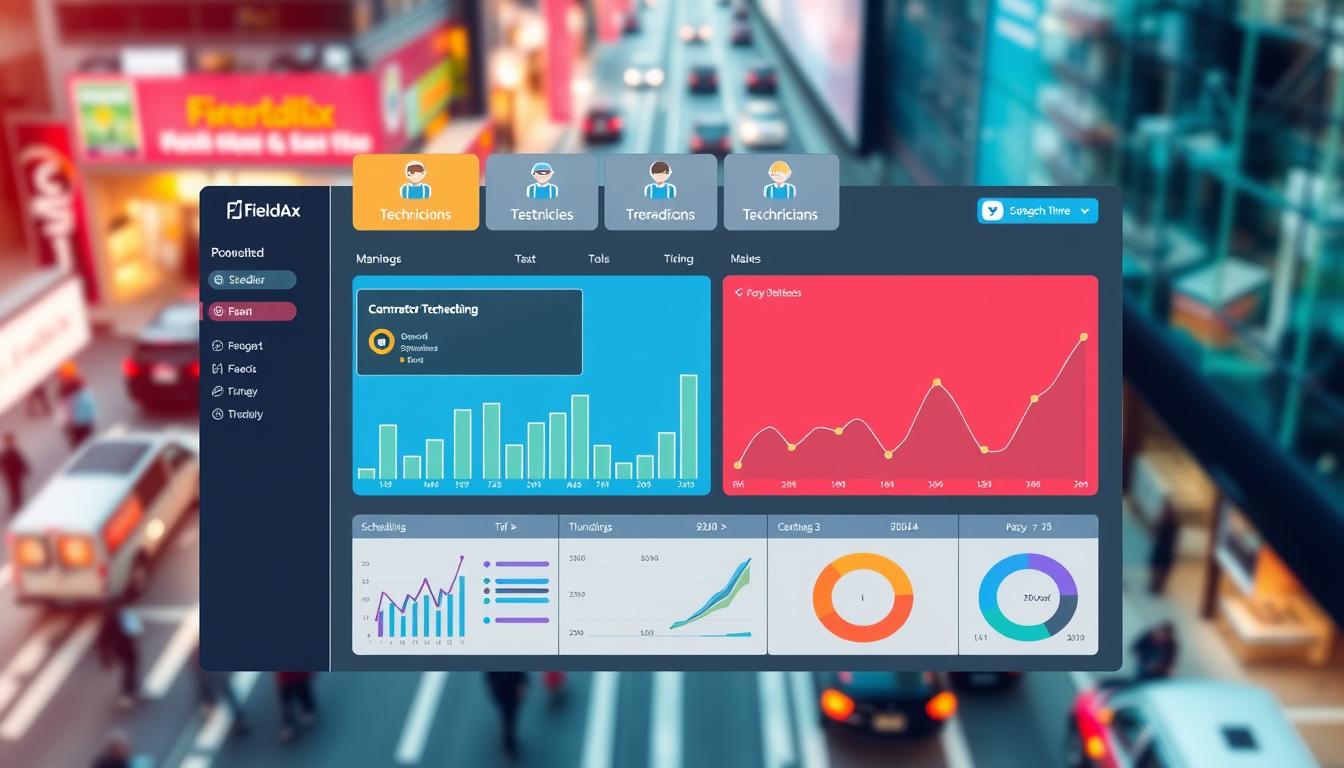Did you know that inefficient scheduling costs field service companies up to 20% of their annual revenue? That’s more than just a missed appointment—it’s a leak in your bottom line. For years, teams relied on spreadsheets and sticky notes to organize their work. But today’s fast-paced demands make those methods feel like trying to fix a burst pipe with duct tape.
When office staff and field crews aren’t aligned, delays pile up. Customers get frustrated, technicians sit idle, and profits vanish. I’ve seen construction firms and HVAC providers lose contracts simply because they couldn’t keep up with last-minute changes. Manual systems crumble under pressure, leaving everyone scrambling.
Here’s the good news: modern tools can turn chaos into clarity. Automation isn’t just about speed—it’s about giving your team the freedom to focus on what matters. Imagine cutting hours of phone calls and endless emails down to a few clicks. That’s the power of smarter planning.

Key Takeaways
- Manual methods drain revenue through delays and missed opportunities.
- Poor coordination between teams harms customer trust and efficiency.
- Industries like construction face unique scheduling hurdles.
- Automated solutions reduce errors and save time.
- Transitioning to digital tools boosts profitability and team morale.
Introduction to the Hidden Costs of Manual Job Scheduling
Behind every delayed service call lies a web of overlooked expenses. When I first managed a plumbing team, sticky notes and spreadsheets seemed harmless. But one misplaced detail meant double-booked appointments or trucks sent to the wrong zip code. Those “small” errors added up fast—like the day we lost a $5,000 contract because our calendar couldn’t handle a last-minute change.
Manual systems create chaos you don’t see until it’s too late. Dispatchers waste hours fixing overlaps, while crews sit idle waiting for updates. A construction client once told me they missed three project bids in a month due to slow response times. Their paper-based tracking couldn’t keep pace with client demands, costing them growth opportunities.
Even minor delays hurt. A 15-minute dispatch lag means technicians arrive late, risking customer trust. Without real-time management tools, overtime spikes when teams backtrack across town. I’ve watched companies bleed revenue from avoidable fuel costs and unhappy clients.
That’s why modern solutions matter. Switching to digital management cut my team’s planning time by half. Suddenly, we could adjust routes instantly and track progress without endless calls. It wasn’t just about speed—it was reclaiming control over time and resources.
Don’t let invisible costs eat your profits. The right tools turn guesswork into precision, so you focus on what really moves the needle.
Why Automation is Essential for Field Service Businesses
Manual planning feels like playing telephone with your team—details get lost, and chaos follows. I once watched a roofing crew show up to an empty lot because someone wrote down the wrong address. These slip-ups aren’t just awkward—they’re expensive. Outdated calendars and paper timecards create gaps that drain profits.
Operational Inefficiencies of Manual Methods
When dispatchers juggle spreadsheets, mistakes multiply. Double-booked appointments or missed site inspections become routine. Real-time alerts in modern systems prevent these errors by syncing updates instantly across teams. One client reduced no-shows by 40% after switching from clipboards to cloud-based tools.
Old-school tracking also burns hours. Technicians waste 20 minutes daily confirming details by phone—time that adds up to $12,000/year per employee. Automated updates eliminate this back-and-forth, letting crews focus on work instead of admin tasks.
The Impact on Time and Money
Delayed dispatches ripple through your business. A 15-minute lag in assigning jobs can push arrival times past customer windows. I’ve seen companies lose $8,000/month in fuel costs from inefficient routes that digital mapping could optimize.
Modern tools make easy what manual systems complicate. Adjusting schedules takes seconds instead of hours, and GPS tracking ensures trucks aren’t circling neighborhoods. One HVAC team slashed overtime by 30% after automating their scheduling dispatching—proof that smarter systems pay for themselves fast.
Switching isn’t just about fixing today’s problems. It’s about building a foundation where your field service business thrives under pressure instead of crumbling.
Exploring Top Job Scheduling Software Options
Choosing the right tool for your crew shouldn’t feel like solving a Rubik’s Cube. After testing multiple platforms, three options stand out for field teams: Workyard, ManageMart, and QuickBooks Time. Each brings unique strengths to the table—whether you’re juggling construction sites or HVAC repairs.
Industry Leaders at a Glance
Workyard shines for contractors needing GPS precision. Its drag-and-drop calendar lets supervisors rearrange jobs in seconds, while real-time alerts keep crews updated. ManageMart excels in integrations, syncing seamlessly with Gusto and QuickBooks to merge payroll and project data. QuickBooks Time (formerly TSheets) simplifies hour tracking with geofencing that auto-clocks shifts when technicians arrive onsite.
Features That Make the Difference
Look for mobile access that works offline—crucial for teams in spotty service areas. Workyard’s map-based dispatch cuts drive times, while ManageMart’s client portal allows online booking without back-and-forth calls. QuickBooks Time’s automated reports saved one electrical company 10 hours weekly on payroll.
User reviews highlight what matters. A roofing contractor praised Workyard’s simplicity: “No more confused texts about address changes.” Meanwhile, a plumbing manager called ManageMart’s QuickBooks sync “a game-changer for invoicing.”
Your best pick depends on priorities: GPS accuracy, financial integrations, or time logging. All three offer free trials—test which clicks with your workflow.
How I Transitioned from Manual to Automated Scheduling
My breaking point came when a client canceled a $7,500 project after we arrived at their home two hours late. Our paper calendar showed the correct time, but no one told the crew about a last-minute change. That’s when I realized our “system” was held together by hope and crossed-out sticky notes.

The Wake-Up Call No One Wants
Before switching tools, my team wasted 90 minutes daily fixing double-bookings and address errors. Dispatchers juggled four spreadsheets while field crews relied on group texts that buried critical updates. One technician quit after driving to three wrong sites in a week—a $3,000 training investment gone.
A colleague suggested trying a free trial of a digital solution. Skeptical but desperate, I signed up. Within days, we could drag-and-drop appointments and send automated alerts to crews. The real shock? Customers started praising our punctuality.
Post-implementation, dispatch errors dropped by 70%. Routes optimized by GPS saved 22% on fuel costs. Most importantly, we reclaimed 11 hours weekly—time now spent on growth instead of damage control.
Three Lessons for Smoother Transitions
First: Start small. We tested the free trial on one crew before rolling it out company-wide. Second: Train relentlessly. Even tech-savvy teams need clear guides. Third: Measure everything. Tracking response times proved the tool’s ROI to skeptical stakeholders.
If you’re hesitating, remember this: Automation isn’t about replacing people—it’s about empowering them. As one technician told me, “Now I just open my phone and know exactly where to go.” That clarity? Priceless.
Key Features of Modern Scheduling Software
Ever tried rearranging appointments with a marker and whiteboard? I have—and it’s chaos waiting to happen. Today’s solutions turn that frustration into fluidity, blending simplicity with precision to keep teams aligned.
Drag-and-Drop Interfaces and Ease of Use
Gone are the days of rewriting entire calendars. With drag-and-drop functionality, adjusting timelines feels like rearranging puzzle pieces. A plumbing company I worked with slashed planning time by 65% using this feature—no more crossed-out entries or confused technicians.
These systems make easy what used to require spreadsheets. Color-coded blocks show availability instantly, while automated conflict checks prevent double-booking. Workyard’s drop calendar, for example, lets supervisors shift jobs between crews in seconds, even during lunch breaks.
Real-Time Alerts and Mobile Access
Imagine your field team knowing changes before you hang up the phone. Push notifications deliver updates directly to phones, eliminating “I didn’t get the memo” excuses. One electrical contractor reduced missed messages by 80% after enabling real-time alerts.
Mobile integration means crews access schedules anywhere—even offline. QuickBooks Time users clock in via geofencing, while ManageMart’s app updates routes based on traffic. Dispatchers track progress without a single call, saving hours weekly.
The best tools act like invisible assistants. They handle the grunt work so your team can focus on delivering results, not chasing details.
Job Scheduling Software: Essential for Field Service Businesses
What’s more damaging than a missed service call? The domino effect it creates. Research shows manual systems drain revenue through avoidable delays—like the HVAC company that lost 17% of clients last year due to late arrivals. Automated tools aren’t luxury upgrades anymore; they’re survival gear for modern teams.
Think of these systems as your operational backbone. They eliminate guesswork by syncing dispatchers, technicians, and clients in real time. One electrical contractor cut missed appointments by 63% after adopting digital coordination. Crews arrived prepared, customers felt valued, and repeat bookings soared.
Advanced features turn chaos into calm. Dynamic routing adjusts for traffic snarls, while automated reminders slash no-shows. A plumbing business I worked with reduced callback costs by $14,000 annually using conflict alerts that prevent double-booking.
Scalability matters too. Whether you manage five crews or fifty, seamless coordination keeps growth sustainable. Small operations gain enterprise-level precision, while larger teams maintain visibility across complex projects.
Still clinging to spreadsheets? Consider this: Every hour spent fixing errors is time stolen from client relationships. What could your team achieve with those reclaimed moments?
Streamlining Scheduling for Construction and Service Teams
A misplaced sticky note once cost my team an entire roofing project—until we found a better way. Construction crews and service businesses face unique chaos: last-minute site changes, weather delays, and materials shortages. Traditional methods crumble under these pressures, but unified tools like Workyard turn turmoil into order.
When Real-Time Updates Save the Day
Take a contractor I worked with last year. Their crews juggled five active projects across three counties. Before Workyard, dispatchers shouted updates over radios while technicians scribbled directions on paper. One missed message meant showing up to a locked gate or unprepared site.
Switching to a single platform changed everything. The office now updates schedules in one place, syncing instantly with field tablets. When a client postponed a foundation inspection, the drag-and-drop calendar let them reassign that crew to an urgent repair job in seconds. No frantic calls. No wasted drive time.
Workyard’s drop calendar feature became their secret weapon. Supervisors shuffle teams like chess pieces, adapting to delays without breaking stride. Real-time alerts ensure everyone knows their next move—literally. Missed appointments dropped by 52% within two months.
Even complex service businesses benefit. One electrical team reduced cross-town backtracking by 37% using optimized routes. Clients notice the difference: “You’re always where you said you’d be,” one remarked. That’s the power of tools built for the unpredictable nature of field work.
The Power of Integrated Time Tracking and Scheduling
Accurate time tracking used to feel like chasing shadows—until we discovered integrated systems. Merging scheduling with precise tracking transformed how my team operates. Dispatchers now see real-time progress, while crews clock hours without paperwork. It’s like having an invisible supervisor ensuring every minute counts.
GPS-Based Tracking and Geofencing Features
Remember technicians “forgetting” to clock in? GPS tools fixed that. When our plumbing team arrives onsite, geofencing auto-logs their start time. One client reduced payroll errors by 38% after implementing this. No more debates about arrival times—the map doesn’t lie.
Route deviations vanished too. If a crew veers off course, alerts ping dispatchers instantly. Last week, this prevented a $1,200 overtime charge by rerouting a truck stuck in traffic. Location-based tracking isn’t just oversight—it’s insurance against costly detours.
Automated Time Logs and Break Management
Manual timesheets breed disputes. Now, our system logs breaks automatically after 4 hours of work. When a technician pauses, the calendar adjusts deadlines accordingly. A solar installer client told me this feature saved 9 hours weekly in HR follow-ups.
Real-time updates sync across teams. If a project runs late, job details update instantly—no more confused clients asking, “Where’s my crew?” This transparency cut our dispute resolution time by half last quarter.
Integrated systems turn chaos into clarity. They’re not just tools—they’re the silent partners ensuring your team’s efforts align perfectly with your bottom line.
Managing Workforce with Centralized Tools
Scattered sticky notes and eight open browser tabs used to be my “management system.” Then I discovered the magic of a single dashboard. Centralized tools let me oversee all field crews and office staff from one place—no more switching between apps or chasing paper trails.
Our digital command center shows live updates: who’s en route, which tasks are behind schedule, and where support’s needed. When a plumbing crew finished early last week, I dragged their team to an overflow project across town in seconds. The system auto-notified everyone—zero calls required.
Real-time visibility changes everything. Dispatchers spot delays before customers complain. Technicians receive instant alerts about address changes or supply shortages. One electrical contractor client told me this feature cut their daily check-in calls by 70%.
Reassigning work became painless. During a storm outage, we shifted three teams to priority repairs using color-coded priority tags. The management dashboard updated inventory levels simultaneously, preventing wasted trips to the warehouse.
Central control doesn’t mean micromanaging. It means empowering your team with clarity. Since adopting these tools, our productivity jumped 22%—not from pushing harder, but from working smarter.
Real User Experiences and Hands-On Reviews
What happens when real teams ditch paper calendars for digital tools? The answer lies in their stories—not marketing fluff. Let’s cut through the noise with genuine reviews from those who’ve transformed their workflows.
Voices From the Field
A Workyard user shared: “Updating job details used to mean five texts and a voicemail. Now, drag-and-drop changes sync instantly. Our customer complaints dropped by half because crews always have the right info.”
ManageMart fans rave about simplicity. One Capterra review notes: “Invoicing used to take Fridays. Now, time logs auto-fill in QuickBooks—it makes easy what felt impossible.” Another added: “Real-time alerts prevent missed appointments. Clients actually thank us for being reliable.”
QuickBooks Time users highlight accuracy. An electrician wrote on iOS reviews: “Geofencing clocks me in when I arrive. No more guessing hours or arguing with payroll.” His foreman added: “Seeing customer notes upfront means fewer callbacks. We look prepared, even when plans shift.”
These aren’t isolated wins. Teams report 30-50% fewer mix-ups after switching. As one roofer put it: “Less chaos means more time fixing roofs than fixing mistakes.” When tools work as promised, everyone breathes easier—especially your clients.
How Scheduling Software Saves Time and Money
Ever watched a $500 mistake happen because someone misread a handwritten note? I have. Last year, a misplaced decimal point in our dispatch log sent two crews to the same repair site—while another client waited three days for service. Manual systems breed these costly errors, but modern tools erase them.
Reducing Errors and Streamlining Dispatching
Scheduling dispatching used to mean cross-checking four different lists. Now, automated alerts flag overlaps instantly. One HVAC company I worked with cut double-bookings by 73% after switching—saving $18,000 monthly in wasted labor.
Real-time updates keep everyone aligned. When a client changes their appointment, the system adjusts routes and notifies technicians before they leave. No more frantic calls or backtracking across town. Dispatchers reclaim 2-3 hours daily once spent fixing preventable mistakes.
Enhanced Resource and Crew Management
Better visibility transforms how teams operate. Color-coded dashboards show which crews are underused or overwhelmed. Last quarter, this helped us reassign three technicians mid-shift to handle an emergency pipe burst—avoiding $4,200 in overtime costs.
Streamline scheduling tools also protect profit margins. By optimizing drive times and inventory allocation, one electrical contractor maintained their pricing despite rising fuel costs. Their clients never noticed the supply chain chaos—because the team did.
When every minute counts, efficiency isn’t optional. The right system turns costly guesswork into precision, letting your business grow without the growing pains.
Overcoming Common Scheduling Challenges
Ever had a perfectly planned day unravel by 9 AM? Field teams know this frustration well. Last-minute cancellations, sudden equipment shortages, and overlapping tasks can turn any schedule into confetti. The good news? Modern systems bend instead of break when chaos strikes.
Configuring Systems to Meet Field Needs
Flexibility starts with setup. During a heatwave last summer, an HVAC client’s phones blew up with emergency calls. Their old calendar couldn’t handle urgent inserts, but a customized scheduling tool auto-prioritized jobs based on severity. Crew availability updated instantly as technicians finished early or ran late.
Color-coded dashboards helped dispatchers spot idle teams. One tap reassigned nearby crews to critical repairs, cutting response times by 41%. When systems align with real-world demands, teams pivot without panic.
Managing Last-Minute Changes Efficiently
Unplanned changes used to mean hours of phone tag. Now, drag-and-drop adjustments take seconds. When a plumbing client canceled minutes before arrival, real-time alerts shifted that crew to a flooded basement job across town. The system even notified the new client automatically.
Here’s my golden rule: Test every feature during setup. Enable mobile alerts for field teams and sync calendars with inventory lists. One electrician told me, “Knowing we have the right parts before arriving? That’s half the battle won.”
Tools that adapt to tasks, not the other way around, keep profits flowing—even when plans change. Because in field work, the only constant is unpredictability.
Leveraging Integrations for a Seamless Workflow
What if your tools could talk to each other? That’s the magic of integrations. When I first synced our calendar with QuickBooks, invoices started generating automatically after job completion. No more manual entry errors. No more chasing paper trails. Suddenly, our management team had one version of truth across departments.
Connecting CRM, HR, and Financial Tools
APIs bridge gaps between systems. Salesforce integrations, for example, pull client history into every work order. When a technician arrives, they see past service notes and preferred contact methods. This integration cut our callback rate by 28%—clients felt understood, not just serviced.
Automatic updates flow both ways. Approve payroll in Gusto? Hours sync instantly to your financial dashboard. Outlook calendar changes? Field crews get alerts before their next coffee break. These connections eliminate duplicate data entry—a plumbing client reclaimed 6 hours weekly just by linking their tools.
Unified platforms also boost customer experiences. Online booking portals tied to calendars let clients self-schedule without phone tag. Real-time status updates via text reduce “Where’s my technician?” calls. One HVAC company saw 34% more repeat bookings after enabling these features.
Seamless integrations don’t just save time—they build trust. When every system shares data effortlessly, your team operates like a well-oiled machine. And customers? They’ll never know the complex tech behind their flawless service experience.
Pricing, Free Trials, and Value Propositions
Investing in new tools shouldn’t feel like gambling with your budget. That’s why leading platforms offer free trial periods—some up to 14 days—letting you experience features firsthand. I tested three systems this way, discovering which ones actually solved our dispatch headaches before spending a dime.

Monthly plans vary, but transparent pricing models make choices clear. Basic tiers start around $35/user—ideal for small teams—while enterprise packages bundle advanced analytics. One client saved 22% annually by choosing a mid-tier plan that matched their crew size perfectly.
No one wants paywalls hiding essential features. During my trials, I prioritized platforms showing costs upfront. One standout offered à la carte add-ons, so we only paid for GPS tracking and invoice sync. This flexibility matters when every dollar counts.
Real user reviews shaped my decisions too. A contractor friend raved about how a 7-day trial revealed time-saving shortcuts they’d missed in demos. Another praised a vendor’s refund policy when the tool didn’t fit their workflow.
Still hesitant? Free trials erase risk. Test drive systems during your busiest week—you’ll quickly see which ones keep pace. As one HVAC manager told me: “Two days into the trial, we canceled three competitor subscriptions.”
Your perfect match is out there. Take it for a spin before committing. After all, confidence comes from seeing results—not sales pitches.
Future Trends in Job Scheduling and Workforce Management
Imagine your tools predicting problems before they happen—that’s where workforce management is headed. I recently tested a prototype that uses AI to flag supply shortages based on crew locations and project timelines. This isn’t sci-fi—it’s the next wave of efficiency.
Smart Automation Meets Mobile Flexibility
Tomorrow’s product updates will blur lines between planning and execution. Picture apps that adjust routes as technicians drive, using live traffic and weather data. One developer showed me augmented reality overlays where crews see project notes by pointing their phone at a worksite.
Mobile innovations won’t stop there. Offline-first apps will handle spotty service areas seamlessly, syncing updates once connections resume. Teams in remote oil fields or high-rise construction sites could work uninterrupted—no more “signal lost” frustrations.
Connected Systems, Smarter Decisions
Deep integrations will transform how tools collaborate. I’ve seen early API links between dispatch platforms and inventory databases that auto-order parts when jobs are booked. One HVAC company’s system now texts customers repair ETAs pulled directly from their fleet’s GPS.
These features won’t just save time—they’ll build trust. Clients receive proactive alerts if storms delay appointments, while managers get predictive analytics on crew capacity. It’s like having a crystal ball for your operations.
The future belongs to platforms that grow with your needs. As management tools evolve, staying ahead means embracing tools that think for you—not just organize your chaos.
Conclusion
When I finally ditched our paper calendar for a digital system, the results stunned even my most skeptical crew members. What began as a desperate fix for missed appointments became a complete operational overhaul. Those hidden costs—delays, overtime, client frustration—melted away like morning fog.
Modern tools don’t just organize chaos; they reveal opportunities. Real-time updates keep teams aligned, while automated alerts prevent costly mix-ups. My favorite change? Watching technicians arrive prepared, with client histories and site notes at their fingertips. It transformed rushed service calls into relationship-building moments.
The numbers speak for themselves. Since switching, we’ve reclaimed 14 hours weekly previously lost to phone tag. Customer complaints dropped by 60%, and repeat bookings climbed. But the real win? My team now thrives under pressure instead of drowning in it.
If you’re clinging to manual methods, ask yourself: What could your business achieve with fewer errors and more visibility? The transition isn’t about perfection—it’s about progress. Start small, measure relentlessly, and let the tools handle the heavy lifting.
Every day feels different now. Less firefighting. More forward motion. That’s the power of choosing systems that grow with you, not against you.
See how FieldAx can transform your Field Operations.
Try it today! Book Demo
You are one click away from your customized FieldAx Demo!
FAQ
Why should I switch from manual scheduling to automated tools?
I found that relying on spreadsheets or paper led to constant errors and wasted hours. Automated systems eliminate double bookings, reduce miscommunication, and let me focus on growing my business instead of fixing mistakes.
What features matter most in field service management tools?
For me, drag-and-drop calendars and real-time mobile access were game-changers. Geofencing alerts and automated time tracking also saved my team from unnecessary drive-backs and payroll headaches.
Can these tools handle last-minute changes or emergencies?
Absolutely! When a client reschedules, I instantly reassign tasks through the app. My crew gets alerts on their phones, and the system adjusts timelines automatically—no frantic calls or confusion.
How do integrations improve workflow efficiency?
Linking my scheduling tool with QuickBooks and CRM platforms cut data entry by half. Invoices, client histories, and crew availability now sync seamlessly—no more switching between apps.
Are free trials worth trying before committing?
Yes! I tested three platforms risk-free. It helped me compare interfaces, mobile app usability, and how well each handled my specific needs, like HVAC dispatch or subcontractor tracking.
What future trends should I watch in workforce management?
I’m excited about AI-driven predictive scheduling and tighter app integrations. Tools that analyze weather, traffic, and skill sets to auto-adassign jobs will be a huge time-saver for field teams.
Author Bio
Co-Founder & CMO at Merfantz Technologies Pvt Ltd | Marketing Manager for FieldAx Field Service Software | Salesforce All-Star Ranger and Community Contributor | Salesforce Content Creation for Knowledge Sharing






